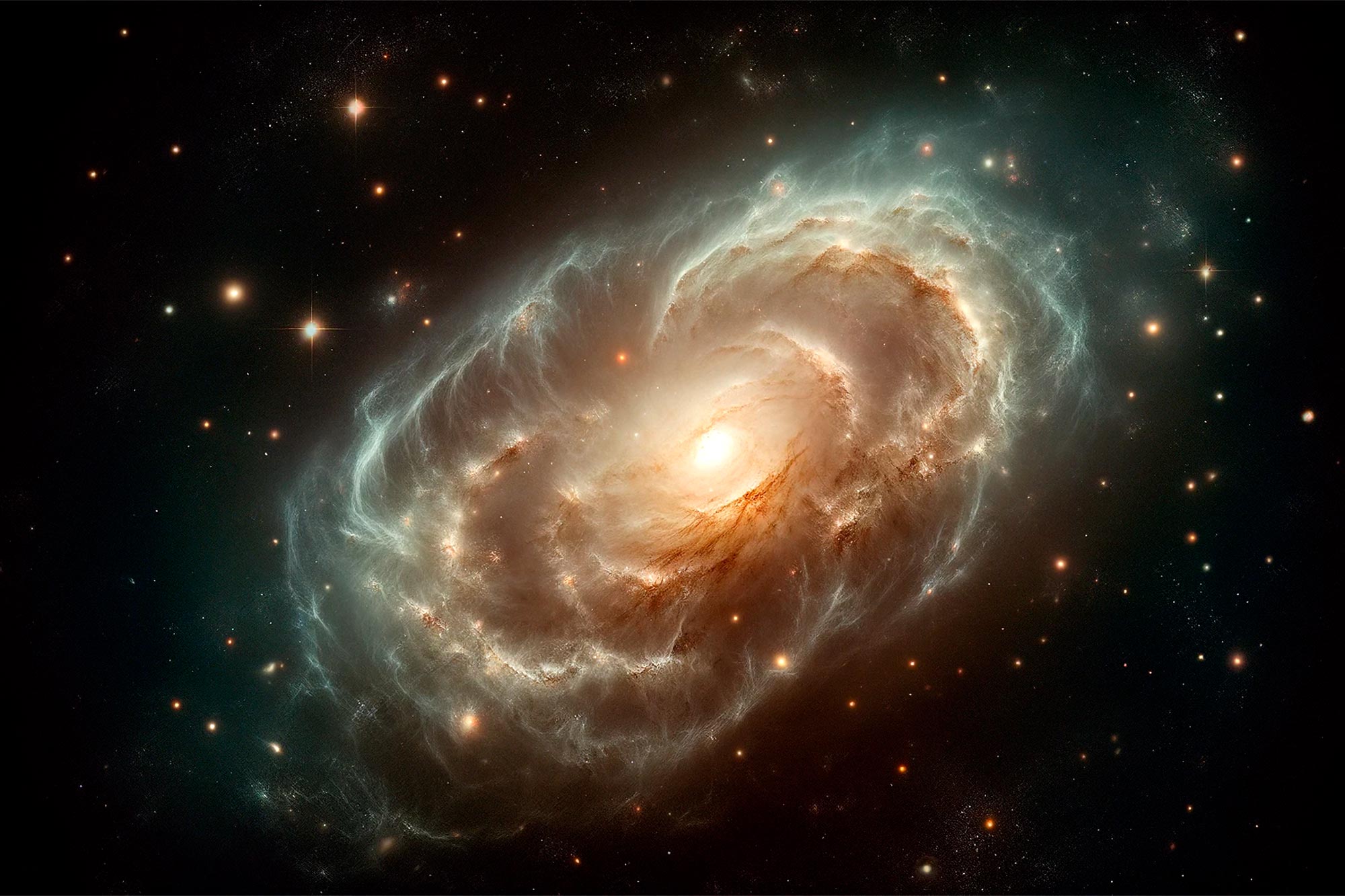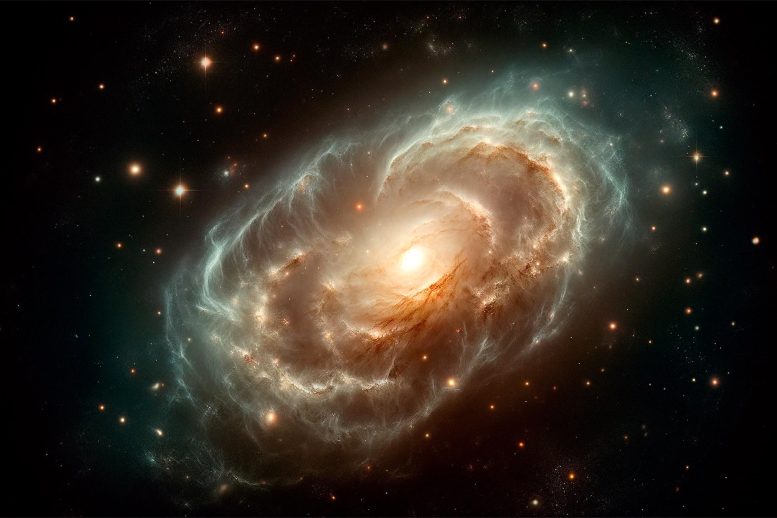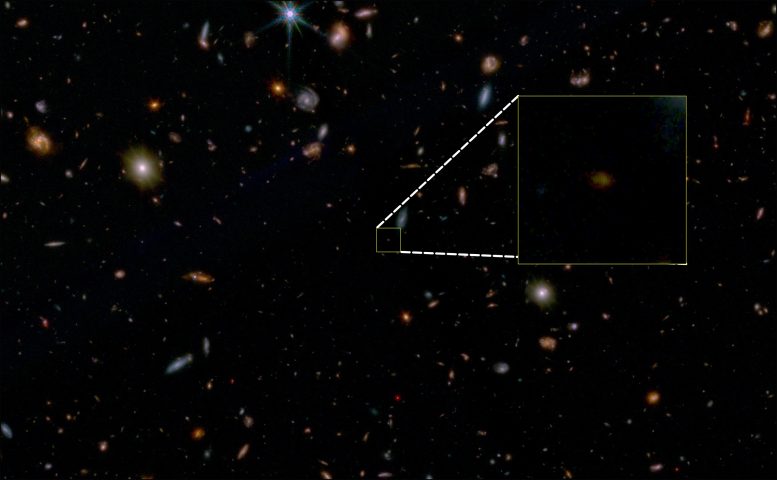

Researchers have discovered the oldest ‘dead’ galaxy, observed 13 billion years after its star formation ceased, using the James Webb Space Telescope. This finding challenges existing theories about galaxy evolution and star formation in the early universe. Credit: SciTechDaily.com
Astronomers using the James Webb Space Telescope found an ancient galaxy with halted star formation, raising questions about galaxy life cycles.
A galaxy that suddenly stopped forming new stars more than 13 billion years ago has been observed by astronomers.
Using the James Webb Space Telescope, an international team of astronomers led by the University of Cambridge and involving LJMU, have spotted a ‘dead’ galaxy when the universe was just 700 million years old, the oldest such galaxy ever observed.
Early Universe Phenomena
This galaxy appears to have lived fast and died young: star formation happened quickly and stopped almost as quickly, which is unexpected for so early in the universe’s evolution. However, it is unclear whether this galaxy’s ‘quenched’ state is temporary or permanent, and what caused it to stop forming new stars.
The results, reported on March 6 in the journal Nature, could be important to help astronomers understand how and why galaxies stop forming new stars, and whether the factors affecting star formation have changed over billions of years.
Causes of Star Formation Cessation
“The first few hundred million years of the universe was a very active phase, with lots of gas clouds collapsing to form new stars,” said Tobias Looser from the Kavli Institute for Cosmology, the paper’s first author. “Galaxies need a rich supply of gas to form new stars, and the early universe was like an all-you-can-eat buffet.”
“It’s only later in the universe that we start to see galaxies stop forming stars, whether that’s due to a black hole or something else,” said co-author Dr. Francesco D’Eugenio, also from the Kavli Institute for Cosmology.

False-color JWST image of a small fraction of the GOODS South field, with JADES-GS-z7-01-QU highlighted. This kind of galaxy is extremely rare. Credit: JADES Collaboration
Astronomers believe that star formation can be slowed or stopped by different factors, all of which will starve a galaxy of the gas it needs to form new stars. Internal factors, such as a supermassive black hole or feedback from star formation, can push gas out of the galaxy, causing star formation to stop rapidly. Alternatively, gas can be consumed very quickly by star formation, without being promptly replenished by fresh gas from the surroundings of the galaxy, resulting in galaxy starvation.
Dr. Renske Smit, part of the investigation team, is based at Liverpool John Moores University’s Astrophysics Research Institute: “We know that in the nearby Universe there exist ‘dead’ galaxies, that unlike our own Milky Way, have stopped forming new stars. However, we don’t know how or why this happens.
“The fate of this particular galaxy is still unknown. It may become a ‘dead’ galaxy or it may be able to re-invigorate itself. We hope to find out.”
Observations and Future Research
Using data from JADES (JWST Advanced Deep Extragalactic Survey), the astronomers determined that this galaxy experienced a short and intense period of star formation over a period between 30 and 90 million years. But between 10 and 20 million years before the point in time where it was observed with Webb, star formation suddenly stopped.
In addition to the oldest, this galaxy is also relatively low mass – about the same as the Small Magellanic Cloud (SMC), a dwarf galaxy near the Milky Way, although the SMC is still forming new stars. Other quenched galaxies in the early universe have been far more massive, but Webb’s improved sensitivity allows smaller and fainter galaxies to be observed and analyzed.
The astronomers say that although it appears dead at the time of observation, it’s possible that in the roughly 13 billion years since, this galaxy may have come back to life and started forming new stars again.
Reference: “A recently quenched galaxy 700 million years after the Big Bang” by Tobias J. Looser, Francesco D’Eugenio, Roberto Maiolino, Joris Witstok, Lester Sandles, Emma Curtis-Lake, Jacopo Chevallard, Sandro Tacchella, Benjamin D. Johnson, William M. Baker, Katherine A. Suess, Stefano Carniani, Pierre Ferruit, Santiago Arribas, Nina Bonaventura, Andrew J. Bunker, Alex J. Cameron, Stephane Charlot, Mirko Curti, Anna de Graaff, Michael V. Maseda, Tim Rawle, Hans-Walter Rix, Bruno Rodríguez Del Pino, Renske Smit, Hannah Übler, Chris Willott, Stacey Alberts, Eiichi Egami, Daniel J. Eisenstein, Ryan Endsley, Ryan Hausen, Marcia Rieke, Brant Robertson, Irene Shivaei, Christina C. Williams, Kristan Boyett, Zuyi Chen, Zhiyuan Ji, Gareth C. Jones, Nimisha Kumari, Erica Nelson, Michele Perna, Aayush Saxena and Jan Scholtz, 6 March 2024, Nature.
DOI: 10.1038/s41586-024-07227-0
The research was supported in part by the European Research Council, the Royal Society, and the Science and Technology Facilities Council (STFC), part of UK Research and Innovation (UKRI).

